An array of prized hina dolls remain at Tamaki.Enjoy an array of prized hina dolls together with Sakata 'kasafuku' ornaments,
which are one of the 3 main hanging ornaments in Japan.
The dolls include 'Kyoho-bina', 'yusoku-bina '(takakura-bina),
'kami-bina '(tachi-bina), and 'Jirozaemon-bina'.
A history of hina dolls in Yamagata Prefecture
As the distribution of goods via the Mogami River developed, cultural articles were brought from Kyoto, and many still remain in Yamagata Prefecture. Those cultural treasures include hina dolls passed down in families throughout the prefecture. The hina dolls created through the years tell of Japanese history, and though their faces and appearance differ depending on the time period, they present highly individual expressions. Event today, Tamaki has an array of valuable hina dolls, such as 'kokin-bina' (traditional dolls with new designs) and 'Kyoho-bina' (dolls from the Kyoho era (1735–1747)). Enjoy the spirit of Japan and travel back in time to the elegant Heian period (794–1185) while surrounded by these hina dolls.
Hina dolls
History and roots of the Doll Festival and nagashi-bina
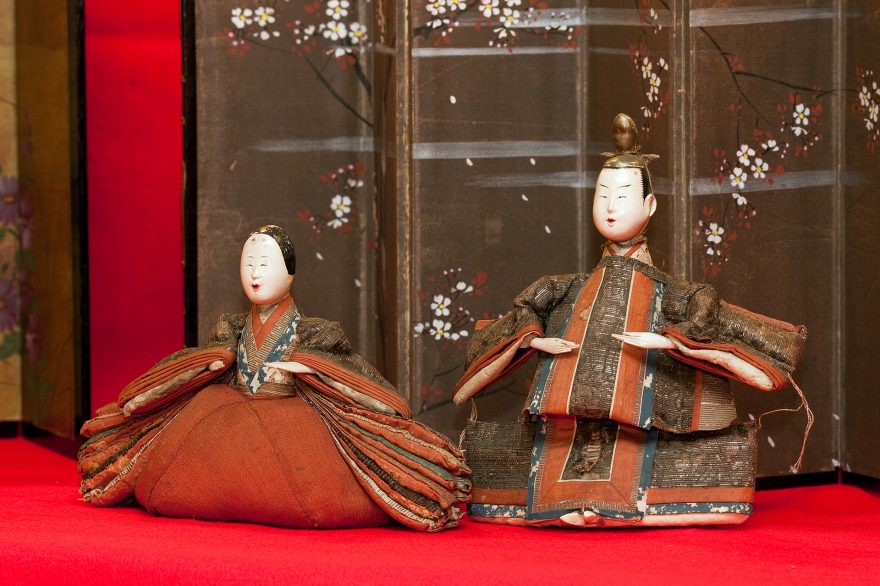
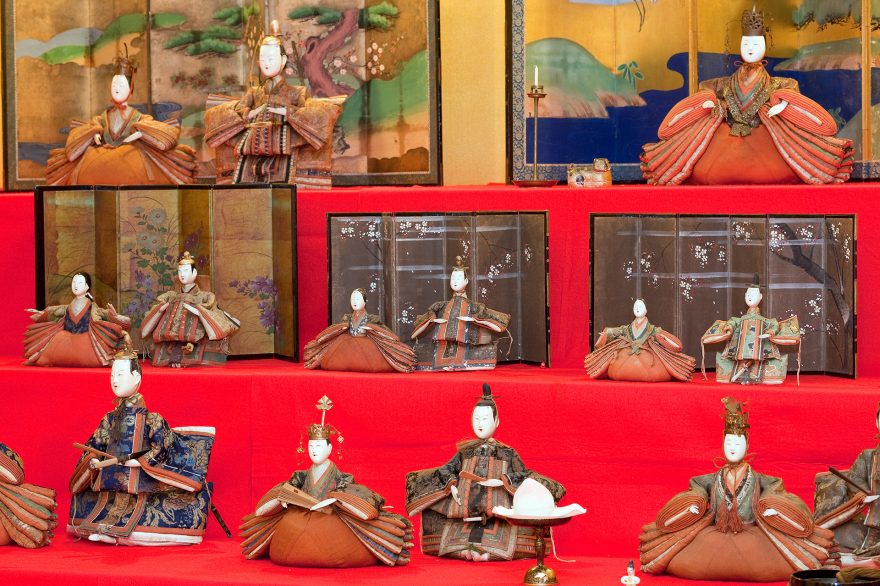
Culture communicated from ancient China
The origins date back to 'Joshi no setsu,' a seasonal banquet that took place in ancient China (around the year 300). 'Joshi' refers to the Day of the Serpent in early March when the seasons are changing. It is said that when the seasons change it is easier for malevolence to cause misfortune, and around this time customs were practiced around water that exorcised impurities.
During this long history of Joshi no setsu in China, the custom was transmitted to Japan from China and linked to Shinto purification rituals. Originally, the exorcism was for the emperor, but in the Heian period it was incorporated in court events and a Gokusui no En festival was held as a 'joshi purification.' A doll was used to stroke the body to transfer the malevolence, then released on a river or the sea. A vestige of this is 'nagashi-bina,' the ritual of floating paper dolls down the river that is held every year at Tamaki.
Dolls Festival for girls' happiness
In addition, over many years the techniques for creating dolls became sophisticated, and the dolls changed from being released on water to decorations. This led to the popularity of hina dolls, or festival dolls representing the emperor and the empress that are displayed on tiered stands. This transformed into a celebration called the Doll's Festival in which Japanese families display decorative dolls to pray for girls' happiness.
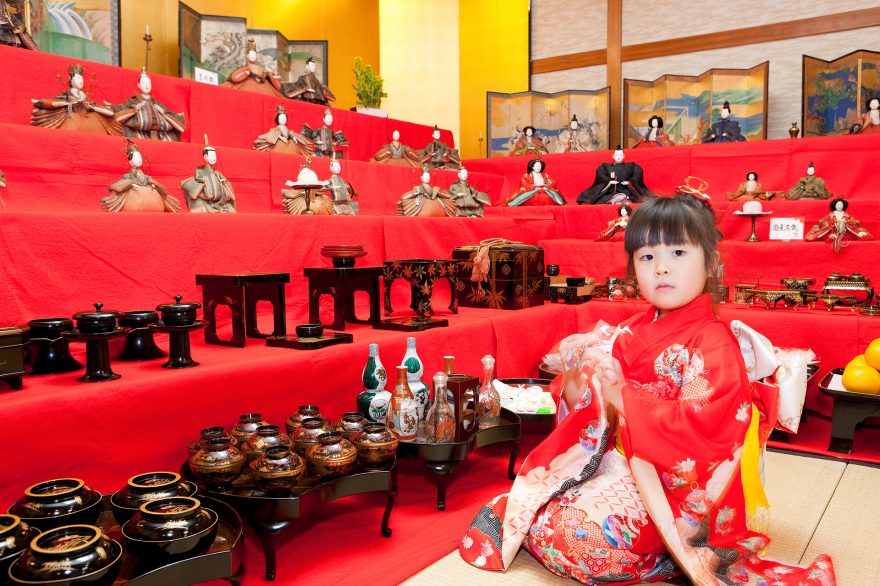
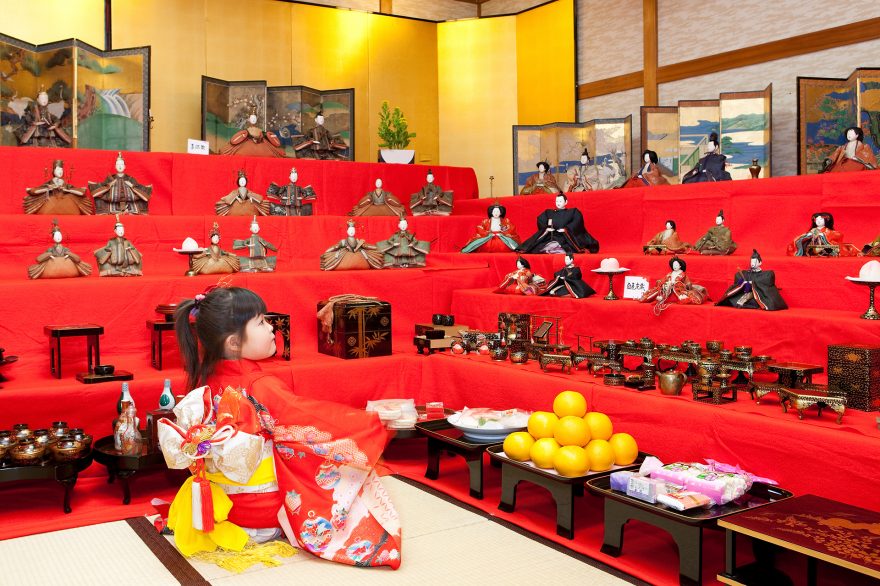
Relationship between hina dolls and marriageable age
During the Doll's Festival, have you ever heard the belief that "if you don't put away the dolls early, your daughter will marry late"? There are various theories about this belief, but one leading explanation is that the hina dolls originally spread in Japanese culture from the Joshi no Sekku culture, an exorcism ritual in ancient China, and since the practice released hina dolls on water to carry away the misfortunes and calamities of our children, they are put away early and not left on display to keep misfortune away (delaying marriage). In addition, displaying the dolls has come to include a mother's desire for her daughter to marry early by displaying the dolls early, and putting them away early so her daughter can get married. Perhaps those kinds of feelings naturally came to be fused with the hina dolls.
What was 'hina asobi' in the Heian period?
Hina asobi, said to have taken place in the Heian period, was similar to the modern version of playing house. The sight of small children playing house with dolls in the park does not seem to have changed since ancient times.
The Doll's Festival today
In association with these beliefs, a set of paper hina dolls in the shape of men and women that bore the misfortunes of people were created and became the original model of Japanese hina dolls. Over many long years, techniques in Japan for crafting hina dolls improved, and they transformed into ornaments from dolls released in water by custom. Hina dolls are said to be vestiges of this.
About hina dolls
Tamaki has many hina dolls that vary widely in appearance. What is the history behind each of these hina dolls? Take a leisurely look at each one and gain a feel for the culture spanning from the ancient Heian period to the Edo period (1615–1868) and Meiji period (1868–1912).
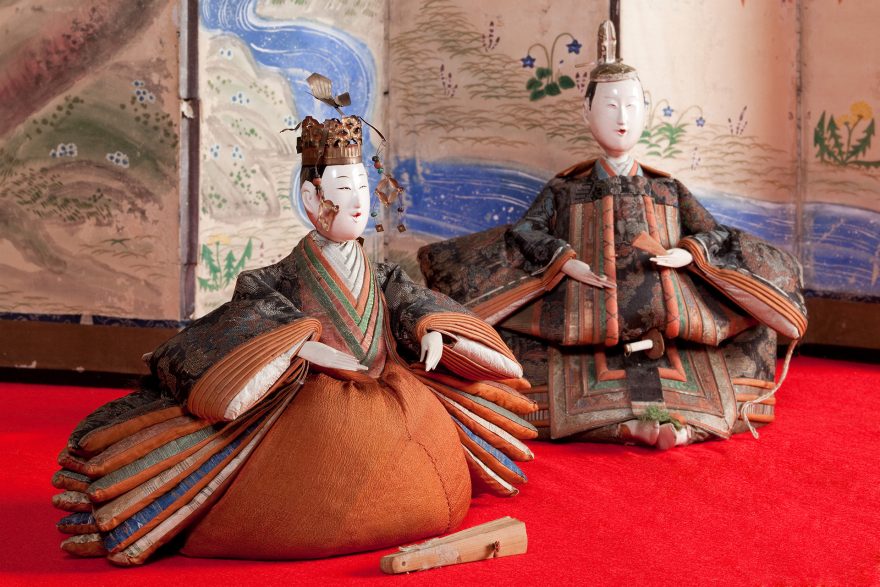
Kyoho-bina
These sitting hina dolls are said to have been popular around the Kyoho era (1735–1747) in the Edo period. The Kanei-bina in the early Edo period were further developed and became more sophisticated, and thus there was a comparatively greater number of large dolls measuring from approx. 45 cm to at times over 60 cm in height. They had long faces similar to the Kanei-bina, and their attire was made with gold brocade and brocade. The male dolls had extremely long sleeves, a sword, and a baton. The female dolls wore a 5-layered kimono, a short coat, 'hakama' pants stuffed with cotton to fill them out, and held a formal fan.
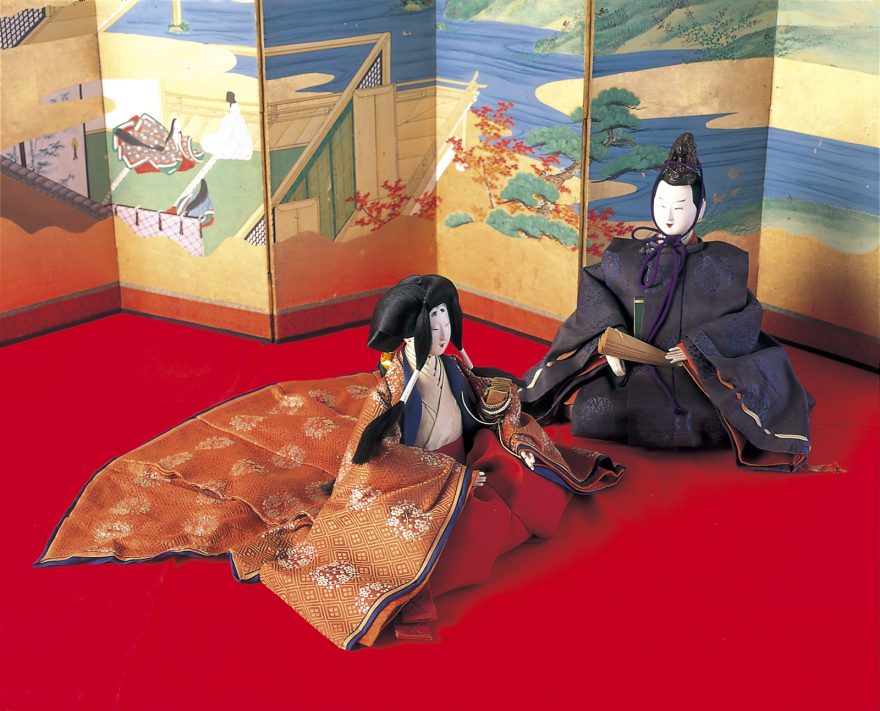
Yusoku-bina (Takakura-bina)
The dress of the nobility was properly tailored for hina dolls based on a manual of the ancient court and military households. They came to be known as yusoku-bina from the Meiji period. Many wore an ancient headdress or the everyday robes of nobility ('noshi-bina'), and they came with a change of clothes. The male noshi-bina had traditional ceremonial court dress, and the female noshi-bina had the ceremonial robes of a court lady. The everyday robes could be changed to the ceremonial robes. The chiseled faces were also realistically crafted, and these dolls became the model for 'kokin-bina' (traditional dolls with new designs).
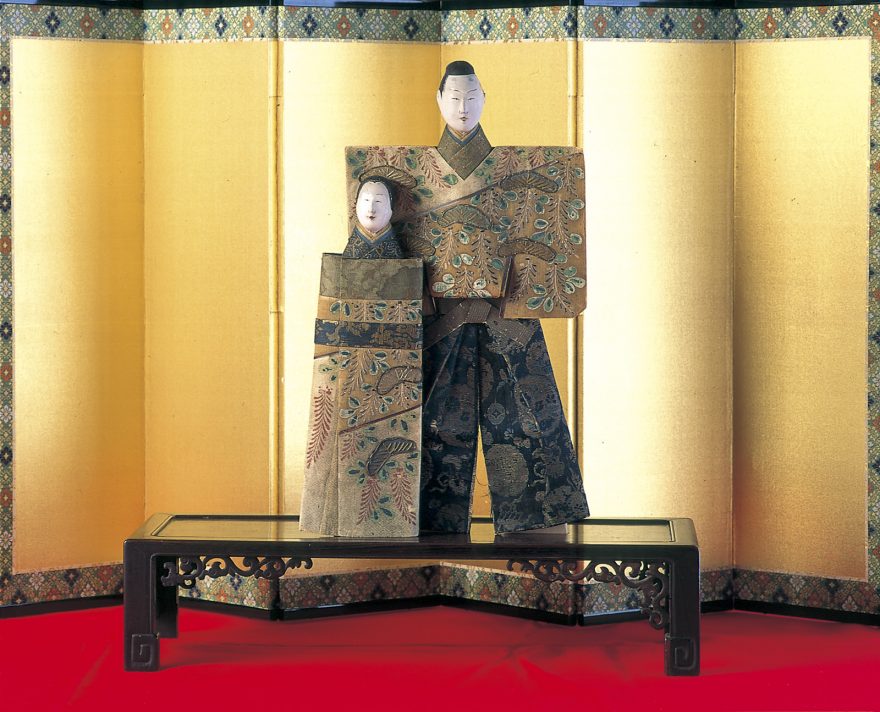
Kami-bina (tachi-bina)
In addition to those created in the Heian period as 'hiina no asobi,' these are hina dolls associated with dolls created as 'katashiro' (paper dolls used in purification rites). In ancient times, the bodies were made flat and could not stand alone, and therefore were displayed using tiered stands and folding screens. In the Edo period, the 'amagatsu' (doll onto which a child's misfortune is transferred) was regarded as a male child and the 'hoko' (charm doll) a female child, and they are said to be the model for a male-female pair of 'tachi-bina' standing dolls. Symbolizing the manners and customs of the Muromachi period, the male doll wears hakama pants and short-sleeved kimono with sleeves spread out, while the female doll has a sash layered over a short-sleeved kimono. These kami-bina are standing, and are called tachi-bina (standing dolls) since they are displayed standing up.
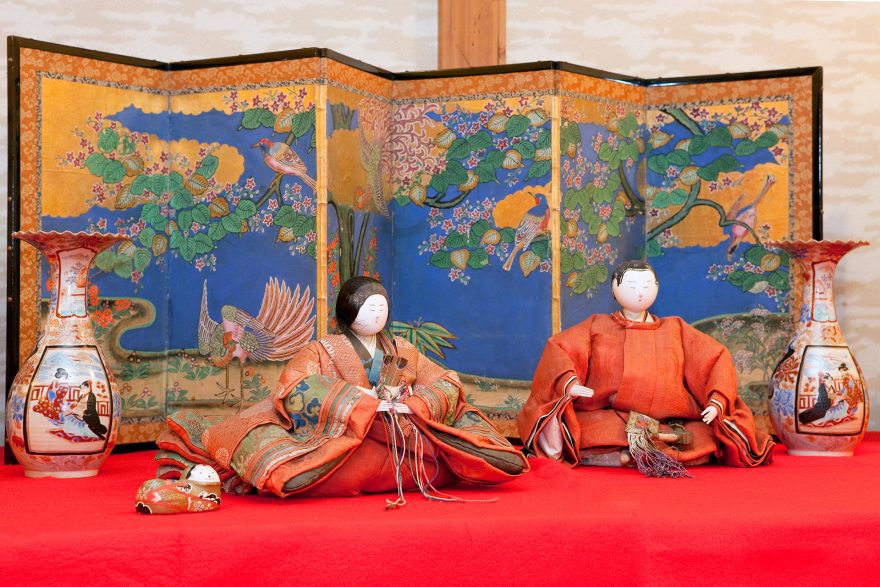
Jirozaemon-bina
These dolls were crafted by Jirozaemon, a doll maker from Kyoto. The hina dolls were for the upper classes, but because the creator expanded to Muromachi, Tokyo, they also spread to the ordinary public, and garnered popularity in Edo (old Tokyo) in place of the past Kyoho-bina. From then on, for approximately 30-some years through the Meiwa, Anei, Tenmei, and Kansei eras, it became exclusively a product of Edo and was widely loved by the lower classes. This type of hina doll is characterized by a comparatively round face in contrast to the long oval faces that had existed until then, and the refined elegance of 'hikime-kagihana' depicting full cheeks, thin horizontal lines for eyes, and a hook-shaped nose. The male dolls were dressed in the clothes of the nobility--a black vest featuring a crest and hakama pants, and the female dolls were dressed in a 5-layered kimono, a short coat, and skirt. There were varying sizes.
Nagashi-bina
Nagashi-bina, the ritual of floating paper dolls down the river, is the origin of the Doll's Festival and has such a long history of tradition in Japan that it is even mentioned in the chapter "Suma" in "The Tale of Genji" (11th century). This ritual developed into 'hiina asobi' in the court, and transformed into the Doll's Festival.
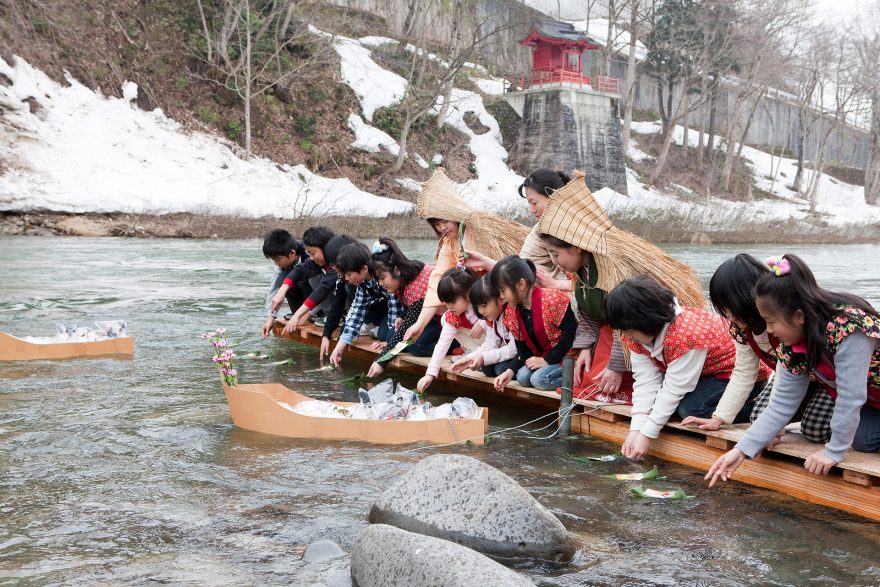
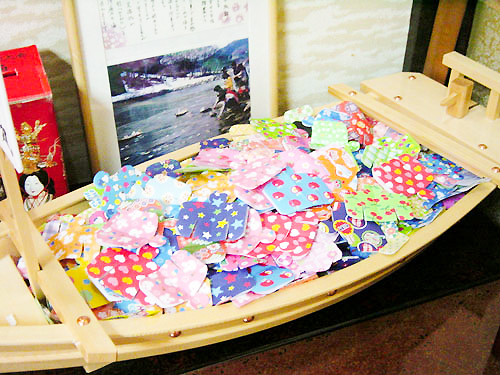
Releasing hina dolls on water to ward off calamity
Picking medicinal herbs for Joshi no Sekku that took place on March 3 was the ancient form of the Doll's Festival, but as time passed people began stroking their bodies with paper dolls (katashiro) and releasing them in the river to exorcise impurities, transforming the ritual to one that wards off calamity. The Doll's Festival and hina-nagashi (floating dolls down the river) are both appreciated by the Japanese and are traditional rituals still seen practiced throughout Japan.
Chiyogami for wishes
Hina-nagashi is a Shinto ritual of releasing 'chiyogami' (colorful decorative paper) bearing written wishes on the clear Sagae River in small boats. In a corner of the room displaying the hina dolls at Tamaki, there are paper dolls to write wishes on for nagashi-bina. In this Shinto ritual, hina-nagashi, various wishes are written on the paper and released on the river to pray for health and happiness. Primarily held on April 4, which is March 3 (Doll's Festival) according to the lunar calendar, the event has passed down through the ages without being impacted by the years.
Hatsuzekku/okuizome
The first festival celebrated after a baby's birth is called 'hatsuzekku.' For boys, it is Tango no Sekku (Boys' Day) on May 5, and for girls it is Joshi no Sekku on March 3. On this day, families celebrate the healthy growth of their child with the idea of warding off misfortune. If this coincides with okuizome (weaning ceremony, or the Momoka Celebration), Tamaki can also prepare appropriate dishes.